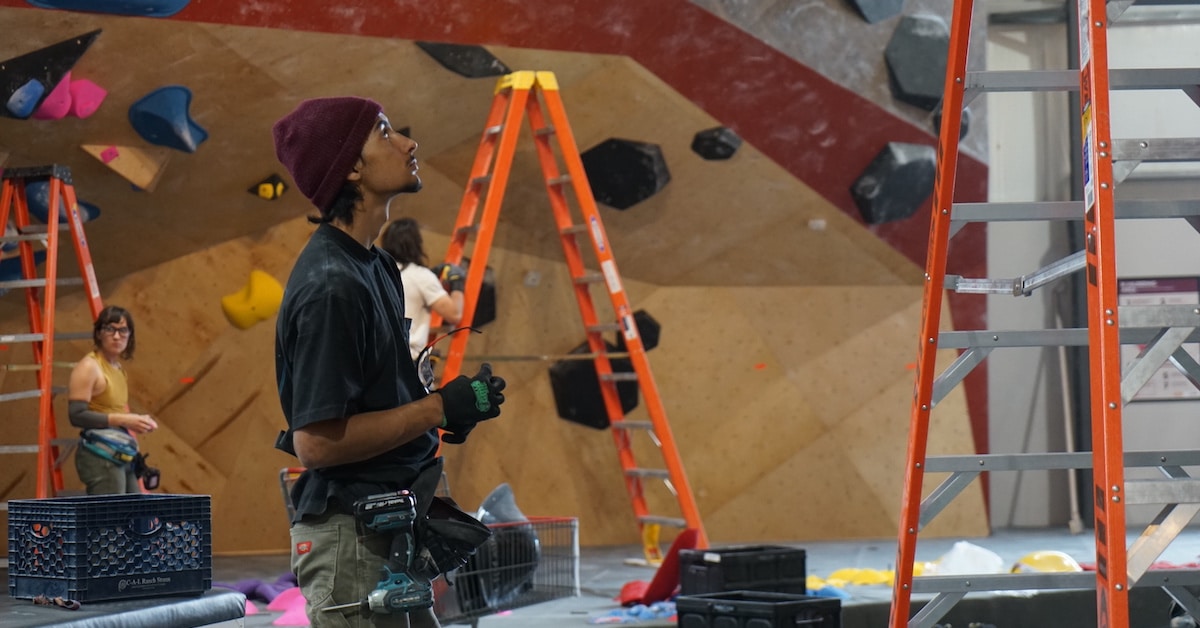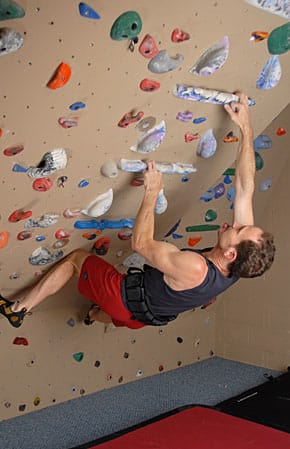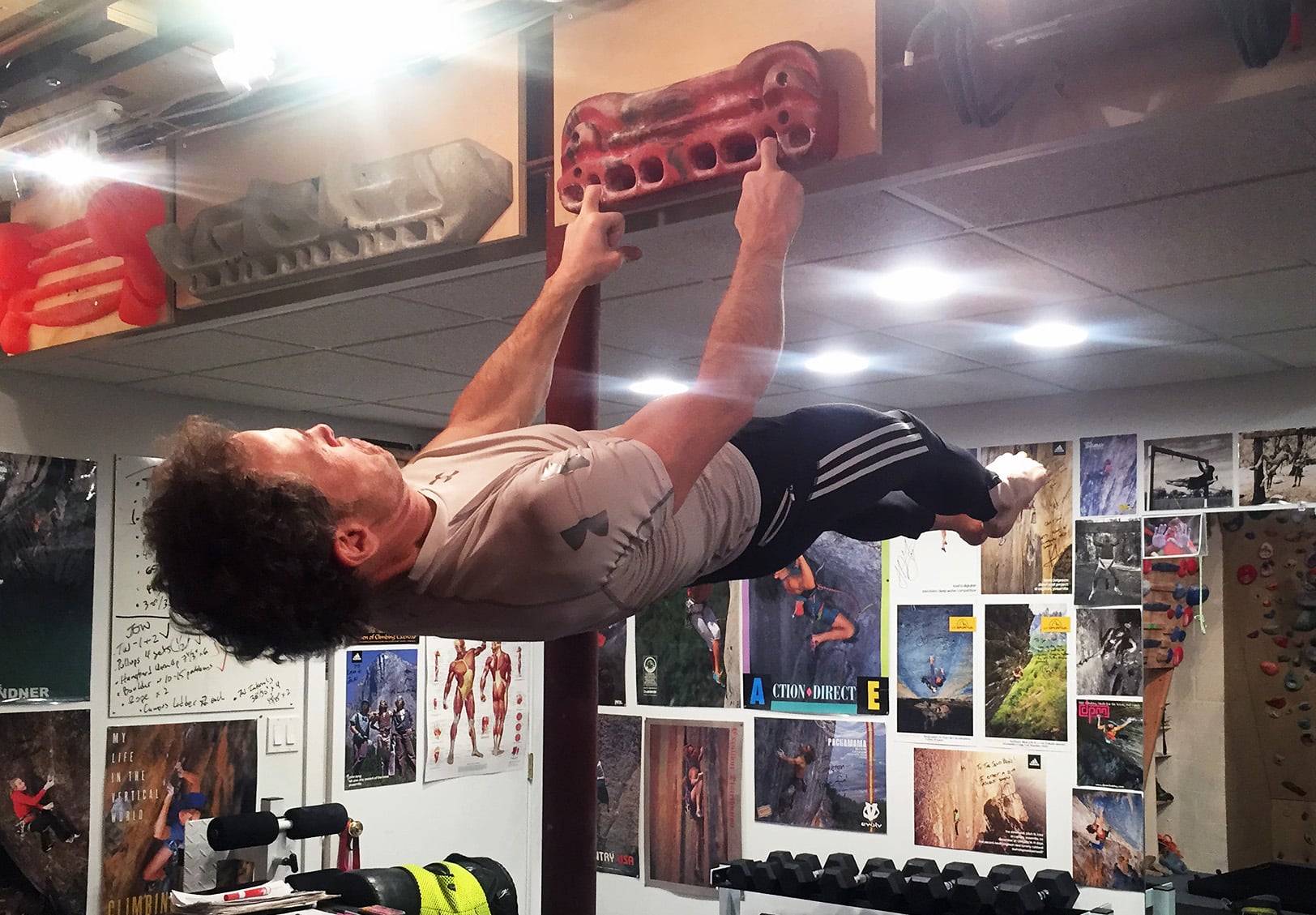Routesetting can be one of the most gratifying jobs out there for enthusiastic climbers. But it can also put so much strain on the body and mind that many routesetters have trouble staying in the game for very long. Use these guides on self-care for routesetters to make your passion for the creative side of climbing last as long as possible.
This is the first in a three-part series on self-care for routesetters. Come back for more on training, scheduling, resting, and nutritional tactics for finding longevity in your career.
Anyone working a physical job knows that one of the most difficult parts isn’t just getting the job done…but making it to the end of each day still in one piece. A job well done doesn’t mean much if you’re too wrecked after wrapping it up to come back and do your best again tomorrow. Longevity matters just as much as quality.

Dynamic duo Holly Chen and Osiris Graves tag-team on volumes during a routesetting clinic at Contact Climbing in St. George, Colorado.
The equation becomes even more complex for a specific sector of the active job population: routesetters. To be a good routesetter, you also have to be a strong climber. Professional and personal climbing pursuits get inextricably intertwined. For better or for worse, your passion plays directly into your work and vice versa. It’s tough—if not impossible—to separate the two.
Without good habits in place, both sides of that equation suffer. Routesetting is backbreaking work, both physically and mentally. The effort it takes to not only haul heavy holds and volumes around for hours on end but also configure them in intricate, intentional, and appropriately challenging ways is nothing short of exhausting. And that doesn’t even include testing and tweaking those creations afterward. The best possible final product requires getting hands-on at every stage of the process. You have to be fully present the entire time. And when you’re not, it’s obvious to everyone you’re setting for.
To complicate things even further, routesetters then have to factor in their personal climbing goals as well. Fitting in a targeted training session during the workweek is a pipe dream most of the time. Forerunning involves plenty of hard climbing, but setters don’t often have much say over the exact styles and difficulties on the docket each day. Gym goers unfortunately don’t want to see endless iterations of your project just so you can practice the crux all afternoon. But by the time you clock out, chances are high that there’s not much gas left in the tank. That rules out most evenings for fitting in supplemental training (assuming you want to avoid an overuse injury). You’re left with the all-too-fleeting weekend to both train or climb outdoors and regroup in time for the next week.
Sometimes it feels like fighting a losing battle trying to do it all. A few key habits, though, help keep everything in better balance. Here’s the first of a few cheatsheets for staying healthy and sane as a routesetter.
#1: Strength Training
Jugging up ropes, scaling ladders, and drilling bolts—all while carrying a load that nearly doubles your weight—takes a toll on the body.
“Setting is sort of like big wall climbing mixed with manual labor,” explains Ben Rathbun, former setting director at Eagle Climbing + Fitness and part of the setting team at Monkeyhouse in Carbondale, CO. “You haul a bunch of stuff around, you aid yourself up the wall with your gear and holds, you’re constantly lifting things and engaging your core and shoulders…and that’s just the setting. Then comes three hours of climbing to forerun all the work you just did. Eight hours of mild to intense physical work, often for days in a row, really adds up.”

Drilling, lifting, and forerunning on a daily basis all take a huge toll on the body for routesetters.
Common Injuries
As the workload builds, routesetters often accumulate a laundry list of pain points beyond typical finger injuries among climbers. These include…
- Tendinitis in the elbows and shoulders
- Neck pain
- Rotator Cuff tears
- Scapular tears
- Herniated discs along the spine
- Strained core muscles
- Strained hip flexors
Most of these injuries occur as a result of muscular imbalances. Routesetting and climbing both build plenty of strength just by doing them, but not in a balanced way. Certain muscles see more action than others, and get stuck overcompensating for weaker ones.
Balanced Strength
Strength training ensures that no muscle bears more than its fair share of the load. Consult your physical therapist for personalized recommendations, but compound exercises like squats, deadlifts, bench presses, and overhead presses make a good starting place for comprehensive strength. Compound exercises work multiple muscle groups with one motion, so they’re the best bang for your buck.
From there, tack on more specific exercises depending on your personal pain points. Elbow tendinitis, for instance, is one of the more common struggles for setters. Rathbun credits isometric holds that work the antagonist muscles in the forearm for healing his chronic elbow pain. For pain on the inside of the elbow, closest to the body, take a heavy dumbbell in your hand with your palm facing up and elbow resting close to the edge of a flat surface. Hold this position, with your arm at about a 90 degree angle, for ten seconds. Release for a few seconds, then repeat for two more sets. For pain on the outside of the elbow, just flip your arm over so that your palm is facing down.
Shorty Strength
Holly Chen from Ubergrippen and The Spot in Denver, CO emphasizes the importance of strength training for women and smaller setters especially. “The numbers don’t lie,” she points out. “If you fill up a haul bucket, you are hauling proportionally more weight than your bigger male counterparts. When you pick up the big extension ladder, your core works harder to keep that center of gravity and the ladder from falling over than your bigger male counterparts.” Strength training makes it possible for her to bridge the physiological gaps and keep up with the rest of the team.
No matter your body type, though, set yourself up for success ahead of time with a commitment to strength training. A solid foundation of overall strength is the ticket to warding off pains and frustrations before they ever set in. And if they do, you’ll have better luck addressing them with the groundwork already in place.
Yes, it’s another thing on the to-do list. Setters are busy and tired enough without adding more to their plates. But even a couple short sessions a week help ease the strain. Any amount of time spent in the weight room is better than being sidelined—from both work and play—with an injury. Ideally, this should be a part of your compensated work day. A routesetter’s body is their most valuable tool for the job. Share this article with your team leader or gym owner to help communicate how strength training translates directly to routesetting productivity and longevity.
Build Your Own Strength Routine
To create a simple strength training workout for routesetters, take one to two exercises from each category below depending on what weak links need your attention. Each of these exercises targets muscles that matter most to routesetters. Strong shoulders, forearms, back, hips, and lower core especially make a huge difference when it comes to lifting heavy holds and volumes, jugging up the wall, stepping up and down ladders, or forerunning tough climbs.
Upper Body Strength Exercises
Overhead Press: helpful for upward-moving shoulder strength
Bench Press: helpful for antagonist chest muscles to balance pulling muscles
Shoulder Raise: helpful for antagonist shoulder muscles to balance pulling muscles
Row: helpful for back and tricep strength
Bicep Curl: helpful for upward-moving arm strength
Isometric Holds and Frying Pans: helpful for elbow tendinitis treatment
Banded Shoulder Rotations: helpful for rotator cuff resilience
TRX I’s, Y’s and T’s: helpful for shoulder and back strength
Lower Body Strength Exercises
Squat: helpful for quad and glute strength
Deadlift: helpful for back and hamstring strength
Single-leg squat: helpful for high-steps and balance
Single-leg deadlift: helpful for balance and mobility
Banded Clamshell: helpful for external hip strength
Banded Hip Flexion: helpful for front hip strength
Adductor Leg Lift: helpful for internal hip strength
Box Jumps: helpful for explosive strength
Core Exercises
Windshield Wipers: helpful for oblique strength
Side-Plank with Dips: helpful for oblique strength
Leg Raises: helpful for quad and lower core strength
Scissor Kicks: helpful for quad and lower core strength
Key Points:
- The manual labor involved in routesetting puts setters at risk of injuries in the shoulders, elbows, back, neck, and hips.
- Strength training can help balance out opposing muscles to prevent overuse injuries.
- Strength training can also help smaller climbers manage the relative difficulty.
- Compound lifts like squats, deadlifts, overhead presses and bench presses make good starting points for building strength because they target multiple muscle groups at once.
- Flesh out your routine with more specific exercises that target your personal pain points.
- Strength training doesn’t have to add much to your workload. Just tack on 15-20 minutes at the end of your forerunning sessions. Think of muscular maintenance as part of your regular work routine.
Copyright © 2000–2022 Lucie Hanes & Eric J. Hörst | All Rights Reserved.











